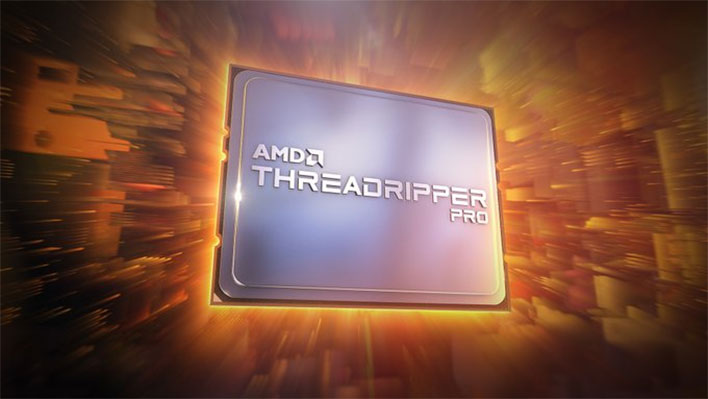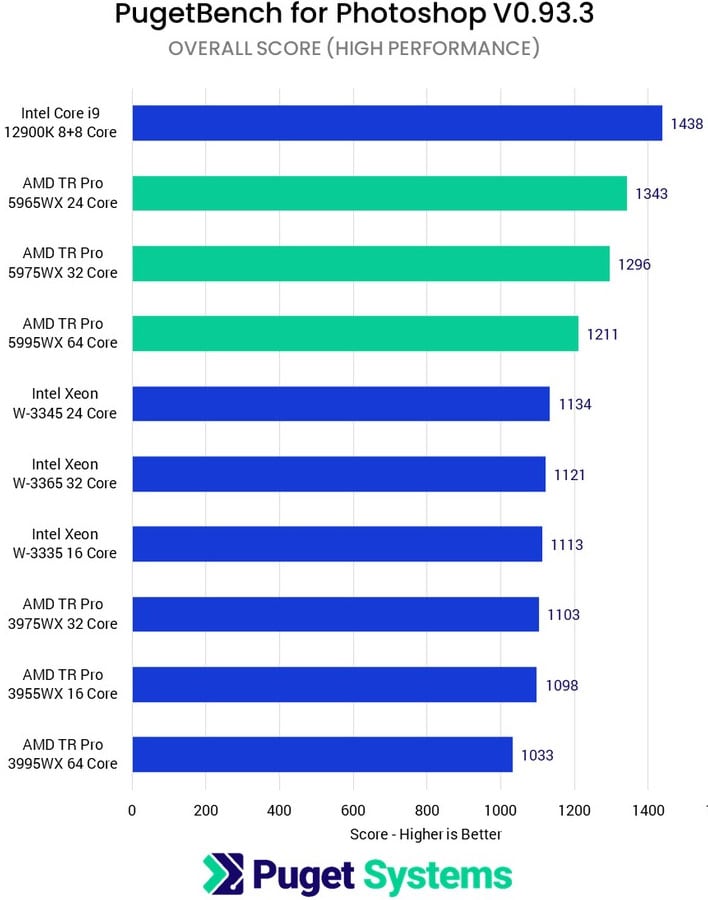AMD Ryzen Threadripper Pro 5000 CPUs Pummel Intel's Xeons In Benchmark Showdown

For anyone who wants to build a monster PC around AMD's Ryzen Threadripper 5000 WX series processors, they'll be able to, with the company confirming plans to bring its latest generation high end desktop (HEDT) chips to the DIY market sometime later this year. What kind of performance can you expect, though? The folks at Puget Systems put the top three models through their paces, pitting them against Intel's Xeon W-3300 series and also a 12th Gen Core i9-12900K Alder Lake processor.
Before we get to the numbers, let's talk about this Threadripper launch. AMD actually first introduced its Threadripper 5000 series CPUs over three months ago, but at the time all five SKUs were exclusively available to Lenovo's ThinkStation PCs. Then last week, AMD announced it was expanding availability to more OEMs in July, followed by the DIY market sometime after.
The Threadripper Pro 5000 WX series is based on Zen 3. With the expanded availability also comes a branding consolidation of sorts, doing away with a separate non-Pro stack.
"Going forward, the Threadripper platform will now use a single 'common infrastructure'. This means there will be one set of Threadripper Pro processors to choose from, with one CPU socket and chipset, and every processor will be based on AMD Ryzen Threadripper Pro silicon," AMD explained last week.
While there are five Threadripper Pro 5000 WX SKUs, AMD only specifically listed the three top models in its blog post announcing the expanded availability. They include:
- Threadripper Pro 5995WX: 64 cores / 128 threads, 2.7GHz to 4.5GHz, 280W TDP
- Threadripper Pro 5975WX: 32 cores / 64 threads, 3.6GHz to 4.5GHz, 280W TDP
- Threadripper Pro 5965WX: 24 cores / 48 threads, 3.8GHz to 4.5GHz, 280W TDP
It wouldn't be shocking if AMD stuck to these three models in the DIY market, considering its mainstream Ryzen processors already scale to 16 cores and 32 threads (Ryzen 9 5950X). Threadripper brings some additional benefits, as does the Pro designation, but the comparative bang-for-buck proposition on AMD's higher end Ryzen desktop CPUs versus its lower end Threadripper CPUs probably makes this the right choice.
Pitting Ryzen Threadripper Pro 5000WX Against Intel Xeon W-3300 And Alder Lake
While the latest Threadripper chips are not yet available in the DIY market, the folks at Puget Systems ran a bunch of benchmarks using each of the aforementioned SKUs, and compared the results with Intel's 32-core/64-thread Xeon W-3356, 24-core/48-thread W-3345, and 16-core/32-thread W-3335. It also tossed in the 16-core (8+8)/20-thread Core i9-12900K for good measure, as well as the previous generation Threaderipper CPUs that the new models replace.
The benchmarks largely focus on workstation workloads, as professional use cases are the primary target for most of these CPUs. And not surprisingly, the Zen 3-based Threadripper 5000WX series waxes AMD's Zen 2-based Threadripper 3000 series CPUs, beating them by big margins in some cases.

In the system builder's After Effects benchmark, AMD's 32-core 5975WX beat Intel's 32-core W-3356 by nearly 40 percent, as well as the previous generation 32-core Threadripper 3975WX by over 44.2 percent. And of course the 64-core created an even bigger performance gap, dusting the W-3365 by 49 percent and the previous-gen 64-core 3995WX by 67.8 percent.
Similar big wins could be observed in benchmarks like Lightroom Classic, Blender, and V-Ray, among others. Lest there be any doubt, Zen 3 is a stout architecture and having a whole bench of cores and threads to throw at workloads can be a boon for workstation chores.
There are some interesting results that didn't always lean in Threadripper's favor, however. Here's a look at Photoshop...

In Photoshop, Intel's mainstream Core i9-12900K actually took the top spot, beating all Threadripper and Xeon processors. It scored 7 percent faster than the top workstation CPU score, and as Puget Systems points out, it costs a "fraction of the price." Photoshop just isn't an application that heavily favors many-core workstation CPUs over mainstream desktop chips.
That wasn't the only benchmark where Alder Lake crawled to the top of the pile. It also posted the best overall score in Premier Pro and posted the highest Active score in Lightroom.
"And in a few cases like Photoshop and Lightroom Classic, going up in core count can actually result in worse performance. This isn't any fault of AMD, but simply an artifact of how certain applications are coded and how boost works on modern CPUs," Puget Systems explains.
All that said, the latest Threadripper chips are looking strong in Puget Systems' testing for professional workloads that scale well with more cores. With Zen 4 looming, though, it will be interesting to see how much interest there ends up being for these Threadripper chips in the DIY market once they arrive.

